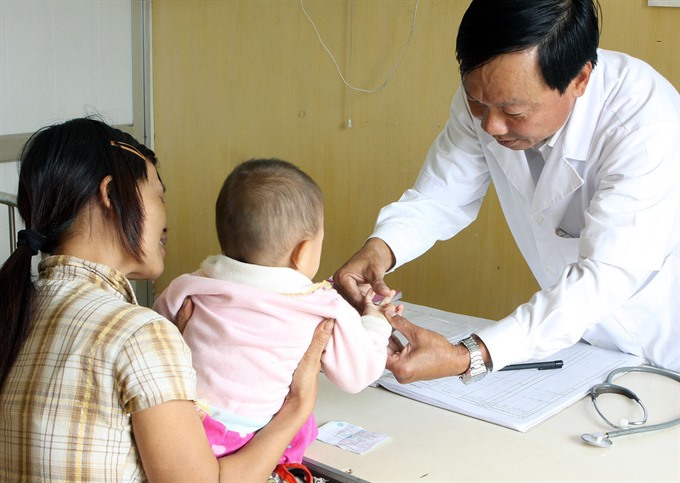

More than 14,700 children affected by HIV/AIDS have received full healthcare, education and nutritional assistance after a national action plan began implementation three years ago.
 |
| A doctor conducts healthcheck to a HIV-infected child in Giao Thủy District, Bình Định Province. – VNA/VNS Photo Dương Ngọc |
HÀ NỘI — Children affected by HIV/AIDS continue to face discrimination and other challenges despite significant gains made in efforts to help them, officials said at a meeting yesterday.
More than 14,700 children affected by HIV/AIDS have received full healthcare, education and nutritional assistance after a national action plan began implementation three years ago.
The 2014-2020 National Action Plan for Children Affected by HIV/AIDS has thus far covered 70 per cent of the targeted children.
The plan defines children affected by HIV/AIDS disease as those who have contracted HIV, those whose parents have died of HIV/AIDS, those living with HIV/AIDS parents, and those with high risk of HIV/AIDS because their parents were drug-users or commercial sex workers.
The figures were revealed at the meeting organised in Ha Noi by the Ministry of Labour, Invalids and Social Affairs (MoLISA) to summarise initial results of the action plan.
MoLISA Deputy Minister Đào Hồng Lan said 248 of 345 centres across the country have been equipped with essential skills to take care for children affected by HIV/AIDS.
At present, 84 per cent of schools in the country were admitting children affected by HIV/AIDS, Lan said.
Việt Nam now has about 21,000 children affected by HIV/AIDS, including 6,800 living with HIV/AIDS.
Among the goals set in the action plan are to provide healthcare, education and nutritional assistance to 90 per cent of affected children by 2020; to equip 90 per cent of centres with skills needed to care for children affected by HIV/AIDS; and to have 100 per cent of schools in the country admit children affected by HIV/AIDS.
Challenges remain
Despite the progress made, challenges remained in assisting children affected by HIV/AIDS, Lan said.
Public awareness of taking care of and protecting children affected by HIV/AIDS had not improved as expected, she said, adding that children affected by the virus and disease still faced discrimination.
Hoàng Đình Cảnh, deputy head of the Việt Nam Administration of HIV/AIDS Control, said lack of knowledgeable staff at HIV/AIDS child care centres was one of the challenges.
The meeting heard that 27 provinces and cities had failed to spend enough money on caring for children affected by HIV/AIDS.
Task force
Lan said her ministry would work with the Health Ministry and the Ministry of Education and Training to meet the national action plan’s targets.
A task force with officials and experts from the three ministries would work to outline the most effective model for supporting children affected by HIV/AIDS in the remaining four years (2017-20), she said.
“:There would be more frequent dissemination of information to raise public awareness and reduce discrimination in our society,” she said.
8,000 new HIV patients
Meanwhile, the Việt Nam Administration of HIV/AIDS Control has announced that about 8,000 people have contracted HIV in the first ten months of this year.
The number marked a slight decline compared to the same period last year, Nguyễn Hoàng Long, head of the administration that functions under the Health Ministry, told online newspaper Vietnam Plus on Monday.
The administration estimates the number of people living with AIDS at 6,500 and HIV-related deaths to reach 2,000 by the end of this year.
The death toll was the same as previous years and is set to rise in certain areas in the coming years, he said.
Long said sexual intercourse had been identified as the most common cause for HIV/AIDS transmission in Việt Nam now. Earlier, the sharing of syringes by drug abusers had been identified as the main cause of transmission.
The most vulnerable groups were wives and partners of HIV/AIDS patients, he said.
“This means that although we had curbed the HIV/AIDS disease’s spread over the past 30 years, the potential for recurrence of an outbreak still exists if we fail to take stricter measures,” he added.
Therefore, Việt Nam would continue giving top priority to achieving the 90-90-90 targets by 2020 (with vision towards 2030), Long said.
The targets are to ensure at least 90 per cent of all people with HIV know their status; 90 per cent of people diagnosed with HIV receive sustained antiretroviral (ARV) therapy; and 90 per cent of all people receiving ARV therapy diagnosed with viral suppression.
According to the Health Ministry, there are over 215,600 people living with HIV in the country, and 88,868 people living with AIDS. The total number of people who’ve died after contracting HIV is 89,412.
The nation observes the National Action Month on HIV/AIDS Prevention and Control between November 10 and December 10 every year. — VNS









